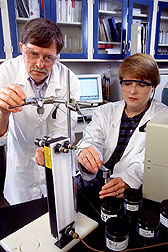This page has been archived and is being provided for reference purposes only. The page is no longer being updated, and therefore, links on the page may be invalid.
Soybean Scraps: Nature's Pollution Solution?
By Erin PeabodyJune 21, 2006
The answer to tomorrow’s water pollution problems could come from soybeans, according to Agricultural Research Service (ARS) scientists. Not from the tender legumes themselves, but from the overly abundant hulls that typically end up as a livestock feed.
ARS chemists Wayne Marshall and Lynda Wartelle have discovered that these undervalued hulls—as well as leftover stalks and stems from already-plucked corn and sugarcane plants—make the ideal foundation for a potent filtering agent that can adsorb harmful levels of lead, chromium, copper and cadmium from contaminated waters.
Marshall and Wartelle—who work at the ARS Southern Regional Research Center (SRRC) in New Orleans, La.—have found that it takes just two simple steps to convert these cheap and abundant crop residues into a powerful magnet capable of snagging both positively- and negatively-charged particles of heavy metals in water.
The material that they’ve succeeded in creating is known as a dual-functioning ion exchange resin. These resins—which are commonly used for treating industrial and municipal waste waters and for recycling heavy metals from solutions—are typically effective in capturing only one kind of particle with either a positive or negative charge.
But the SRRC researchers’ resins can grab both. And Marshall has found that they’re more cost-effective than two synthetically-made resins currently in use.
Ion exchange resins work by swapping, or exchanging, the undesirable ions in a water supply with benign ones. In a classic example of this interplay, water softeners work by drawing out and replacing unwanted “hard water” particles, like calcium and magnesium, with ions from sodium.
Marshall and Wartelle give their plant residues a negative charge by adding citric acid, a common food industry additive. The positive charge comes from choline chloride, which the researchers bind to plant fibers by adding DMDHEU (or dimethyloldihydroxyethylene urea)—a chemical that’s already known for making molecules stick. In the textile industry, it’s the compound that helps dye cling to cotton and wool fibers.
ARS is the U.S. Department of Agriculture’s chief scientific research agency.

